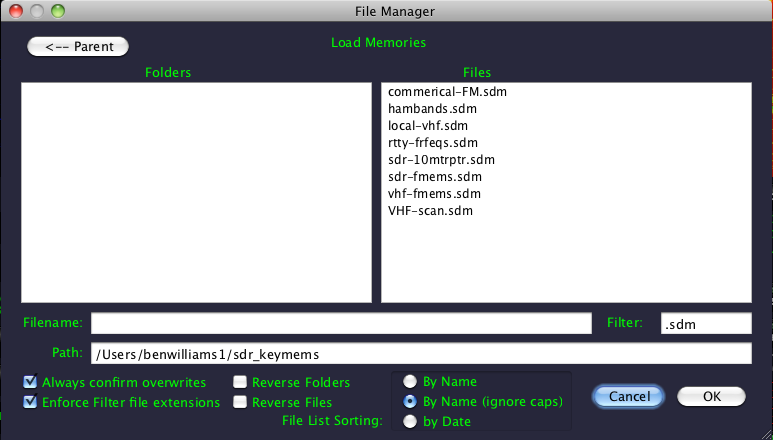Beta Address: http://blish.org/sdrdxdoc/memories.html
5.16 - Memories
5.16.1 - Store and Recall

SdrDx's File Dialog. Folders on the left, files on the right.
If you want to see everything, clear the Filter field.
The 1 through 0 and F1 through F10 ( F15 on some computers) keys serve as twenty to twenty-five memories. Pressing (which will flash... to cancel, hit again) and then a number- or f-key, or Shift with one of these keys stores the current frequency, waterfall setting, high and low pass filter settings, squelch, CW offset, and demodulator mode in the memory. In addition, preset memories store the tuning steps appropriate for the band and mode.
If is on, then hovering the mouse pointer over a memory button on the GUI will display the frequency stored in that memory. If is off, you can still have this feature on, just turn on
Pressing the 1 through 0 or F1 through F10 keys will recall that memory immediately. You can save and reload full memory sets.

Stored Memories
if is on, then when you have SdrDx set to a portion of the spectrum where you have memories saved, they will be displayed as shown at the right.
You have complete control over how these memories act via the , , , , , and controls. Each of these controls an aspect of memory recall; respectively, they switch whether memory recall sets the notches, the tuning step (for preset memories), low pass filter, high pass filter, waterfall intercept, the squelch level, and the CW offset.
5.16.2 - Preset Amateur Bands
Pressing ^ 1 through ^ 0 will recall one of ten preset amateur band edges, and set the appropriate demodulator mode for that band.
5.16.3 - More Memories
Pressing F1 through F10 (or higher on some Mac keyboards, if you have set OS X preferences to allow these function keys to be used) provides another ten to fifteen memories. Shift and the FKey stores a memory, the FKey alone recalls it.
5.16.4 - Preset Time and SW Bands
From the keyboard, pressing ^ F1 through ^ F10 recalls either preset time stations, or the SW broadcast bands. Press O to change the FKeys between time stations and SW band presets.
From the GUI, press to select time stations instead of SW broadcast bands, then press , followed by an FKEY F1...F10 or one of the memory buttons.
5.16.5 - Saving and Loading Memory Sets
All memories are saved when the program is quit, and restored the next time you start the program.
You can also save and load memories at any time using and . When saving, be sure to name them in such a way as to easily distinguish them from one another when you go to reload them.
5.16.6 - Preset Zones

Zone Numbering Display (Aqua numbers at top)
When using the memories in real life, at first I found that I would memorize a station here, then one there... I was pretty disorganized. After a while I found myself trying to use the 1 ... 0 and F1 ... F10 keys in the same order as the ten spans of the signal graph area.
But then I had to count them. So at the top, I added the numbers 1 though 9 and zero to match the number keys; now, if I see a signal in a band, I use the number or FKEY that matches the zone number, and then it is easy to remember which memory key to use to get back to a particular signal. A long explanation for a simple feature, but I think you'll also find it useful if you try it.
This feature works very well with i, which initializes each of the ten memories in the 1 through 0 keys with the center of each of the ten zones on-screen at the time it is pressed. So one approach to operating is, tune to a band segment, then press i; then when you see a signal you want to capture, press the number key that matches the on-screen zone, that will get you close; then use the + / - , { } and square bracket keys to fine tune, press shift-number for the zone, and now you've got a signal captured for that zone. Another benefit of i is it will keep previous memories from taking you off-band, which can be inconvenient.
If you don't like this feature, you can turn it off in the dialog accessed with — just uncheck  Draw Zones . That will disable the drawing and the i command effect.
Draw Zones . That will disable the drawing and the i command effect.
| toc | index | guide | changes | keyboard | , previous | . next |
 SK
SK